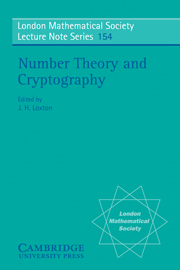Book contents
- Frontmatter
- Contents
- Contributors
- Introduction
- I NUMBER THEORETIC ASPECTS OF CRYPTOLOGY
- II CRYPTOGRAPHIC DEVICES AND APPLICATIONS
- 7 Security in telecommunication services over the next decade
- 8 Linear feedback shift registers and stream ciphers
- 9 Applying randomness tests to commercial level block ciphers
- 10 Pseudo-random sequence generators using structured noise
- 11 Privacy for MACNET
- 12 Authentication
- 13 Insecurity of the knapsack one-time pad
- 14 The tactical frequency management problem: heuristic search and simulated annealing
- 15 Reed-Solomon coding in the complex field
- PART III DIOPHANTINE ANALYSIS
15 - Reed-Solomon coding in the complex field
Published online by Cambridge University Press: 05 May 2013
- Frontmatter
- Contents
- Contributors
- Introduction
- I NUMBER THEORETIC ASPECTS OF CRYPTOLOGY
- II CRYPTOGRAPHIC DEVICES AND APPLICATIONS
- 7 Security in telecommunication services over the next decade
- 8 Linear feedback shift registers and stream ciphers
- 9 Applying randomness tests to commercial level block ciphers
- 10 Pseudo-random sequence generators using structured noise
- 11 Privacy for MACNET
- 12 Authentication
- 13 Insecurity of the knapsack one-time pad
- 14 The tactical frequency management problem: heuristic search and simulated annealing
- 15 Reed-Solomon coding in the complex field
- PART III DIOPHANTINE ANALYSIS
Summary
Reed-Solomon error correction codes are powerful codes which allow efficient correction of multiple burst errors. The (n, k) Reed-Solomon code takes strings of n symbols, each containing k information symbols and n – k check symbols and can correct any occurrence of at most ½(n – k) incorrectly received symbols ([4]). The Reed-Solomon code is usually implemented via computation in a finite field of characteristic 2. However, this requires special circuits for encoding and decoding which have only recently become economic.
There is an alternative ‘spectral’ interpretation which uses ordinary complex arithmetic. This has the advantage that conventional floating point devices can be used for encoding and decoding. Its compensating disadvantage is that the arithmetic is no longer exact. For the purposes of this example, let us assume that we would like to code k = ½n message symbols and that we wish to correct up to ¼n incorrectly received symbols. First, pad the ½n length message sequence with a ‘prefix’ of ½n zero symbols. We view the resulting sequence as a sequence of spectral magnitudes. Thus it has a characteristic ‘high-pass’ spectrum, that is all low frequency spectral magnitudes are zero. Next, take the inverse fourier transform of the high-pass spectrum and transmit the resulting time domain sequence. The characteristic high-pass spectrum, that is zero symbols in the first ½n spectral bands, is spread over the entire n time domain components.
- Type
- Chapter
- Information
- Number Theory and Cryptography , pp. 175 - 176Publisher: Cambridge University PressPrint publication year: 1990



